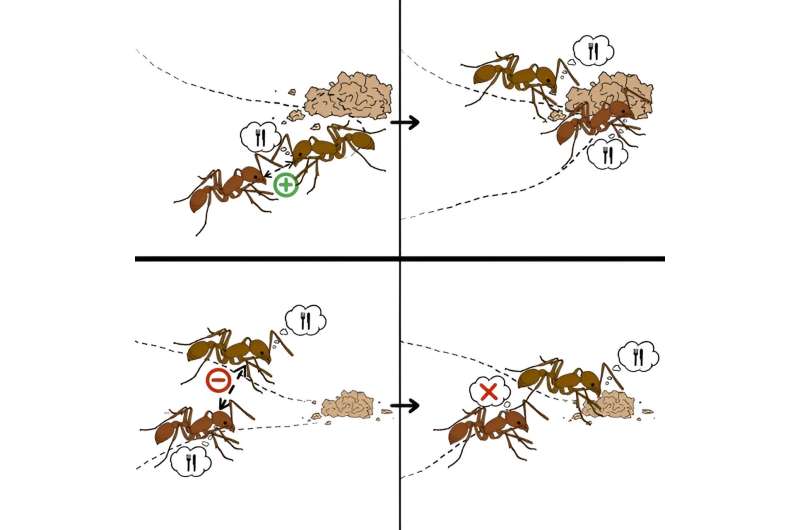This article has been reviewed according to Science X's editorial process and policies. Editors have highlighted the following attributes while ensuring the content's credibility:
fact-checked
peer-reviewed publication
trusted source
proofread
Social contagion research explores how ant colonies regulate group behaviors

In the world of social creatures, from humans to ants, the spread of behaviors through a group—known as social contagion—is a well-documented phenomenon. This process, driven by social imitation and pressure, causes individuals to adopt behaviors observed in their peers, often resulting in synchronized mass actions: Think of stampedes, or standing ovations.
Social contagion is a double-edged sword in highly integrated societies. While it facilitates cohesion and collective efficiency, unchecked contagion can lead to detrimental mass behaviors, such as mass panic. Thus, nature has evolved regulatory mechanisms to keep such behaviors in check.
One such mechanism is reverse social contagion. In reverse social contagions, increased interactions between individuals engaged in a behavior lead to a higher likelihood of them stopping that behavior, rather than engaging in it.
In a paper published in PNAS Nexus, researchers led by Maurizio Porfiri—NYU Tandon Institute Professor of Professor of Biomedical Engineering, Mechanical and Aerospace Engineering, and Civil and Urban Engineering, as well as the director of its Center for Urban Science and Progress (CUSP)—describe this unique phenomenon in colonies of harvester ants (Pogonomyrmex californicus) in order to understand the energetic consequences of highly integrated social behavior.
"Ants colonies reduce their energy spending per individual as the colony grows, similar to the size-dependent scaling of metabolic costs in birds and mammals discovered by Kleiber almost a century ago," said Porfiri. "To date, a convincing explanation of how this collective response emerges is lacking."
Utilizing tracked video recordings of several colonies, they discovered that individual ants did not increase their activity levels in proportion to the colony size. This was a curious finding, because larger colonies means more interactions between their members, and more opportunities for reinforcing behaviors.
To decode this behavior, the team—who also includes Pietro De Lellis from the University of Naples, Eighdi Aung and (Tandon alum) Nicole Abaid from Virginia Tech, Jane S. Waters from Providence College, and Santiago Meneses and Simon Garnier from the New Jersey Institute of Technology—applied scaling theories typically used to study human settlements.
They derived relationships linking colony size to interaction networks and activity levels, hypothesizing that reverse social contagion was at play. Their hypothesis was supported by respirometry data, which revealed a potential connection between ant activity and metabolism.
Imagine you are an ant, and you see one of your fellow workers foraging for food. If you are governed by social contagion, you might also begin foraging so you don't look lazy. But the energy you expend foraging might not be worth it if one ant can efficiently gather the food.
In this case, reverse social contagion tells you to kick your feet up and relax while you let your compatriot do the work, because you'll need your energy later for another task. In this way, restraining social contagion makes the colony more efficient.
The study draws a fascinating parallel between insect colonies and human cities. In both systems, social interactions influence energy expenditure, but in opposite directions.
Insect colonies exhibit hypometric scaling—activity levels do not increase proportionally with colony size. In contrast, human cities show hypermetric scaling, where energy expenditure grows faster than the population size.
"Human behavior is often driven by personal gain," says Simon Garnier, Associate Professor of Biological Sciences at NJIT and senior author on the paper. "Ants, on the other hand, tend to prioritize the needs of the colony over their own. This has huge implications for understanding the differences between the organization of human and social insect societies."
Unlike humans, ants manage their energy as a colony rather than individually, somehow displaying a cooperative response. This study shows that ants use reverse social contagion to regulate their overall activity and energy use.
Essentially, when many ants are busy with a task, some will stop to prevent the entire colony from overworking. This behavior aligns with scaling laws and metabolic patterns seen in other biological systems.
In simpler terms, think of an ant colony as one big organism where every ant's actions are coordinated for the colony's benefit, not just their own. Future research will look into how exactly these ants communicate and manage their energy so efficiently.
This research not only sheds light on the regulatory mechanisms in ant colonies but also offers insights into the broader principles of social regulation across species. As we continue to explore these parallels, we may uncover more about the fundamental dynamics that govern both natural and human-made systems.
"This is the first step we are taking to understand and model energy regulation in ant colonies," said Porfiri.
"Is energy regulation accompanied by improved performance for the collective? Can we design algorithms for robot teams inspired by ants that can maximize performance and minimize energy costs? Can we learn some lessons for our city transportation networks? These are just some of the questions we would like to address next."
More information: Maurizio Porfiri et al, Reverse social contagion as a mechanism for regulating mass behaviors in highly integrated social systems, PNAS Nexus (2024). DOI: 10.1093/pnasnexus/pgae246
Journal information: PNAS Nexus
Provided by NYU Tandon School of Engineering




















